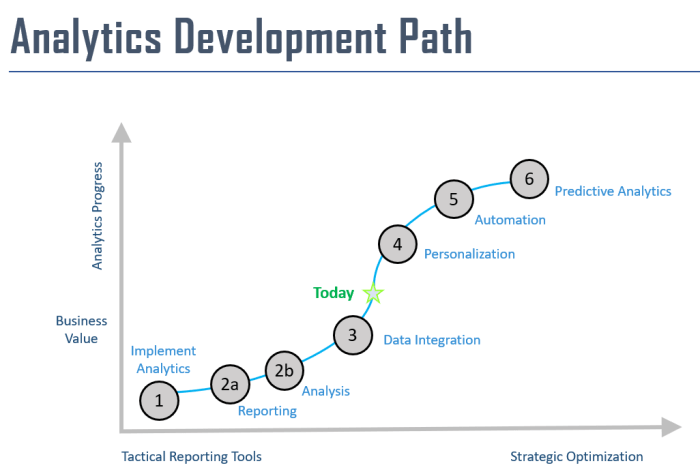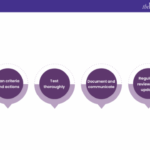Building an actionable analytics practice is crucial for any business looking to leverage data for informed decision-making. This guide dives deep into the essential elements, from defining your analytics goals to fostering a data-driven culture. We’ll explore how to transform raw data into actionable insights, ultimately boosting your bottom line.
We’ll cover everything from identifying the right data sources and ensuring data quality to developing the skills needed for a successful analytics team. We’ll also examine how to implement data-driven processes, communicate findings effectively, and create a data-centric organizational culture. Finally, we’ll look at how to measure the success and impact of your analytics efforts.
Defining an Actionable Analytics Practice
An actionable analytics practice transcends the traditional limitations of data analysis. It’s not just about collecting and visualizing data; it’s about translating insights into tangible, measurable business outcomes. This approach requires a shift in mindset, moving from simply understanding what happened to proactively influencing what will happen. The key is to empower decision-makers with the data and insights they need to make informed, data-driven choices.This shift from descriptive to prescriptive analytics requires a deep understanding of the business context, and a clear articulation of the questions that need answering.
An actionable analytics practice demands more than just identifying trends; it demands understanding the drivers behind those trends and using that understanding to create a strategic advantage.
Defining Actionable Analytics
An actionable analytics practice is characterized by its focus on translating data insights into concrete, measurable improvements. It distinguishes itself from descriptive analytics, which simply describes past events, and diagnostic analytics, which explores the reasons behind those events. Actionable analytics, however, goes a step further, using predictive modeling and prescriptive recommendations to shape future decisions.
Key Characteristics of Actionable Analytics
An actionable analytics practice possesses several key characteristics that differentiate it from its less strategic counterparts. These characteristics are crucial for translating insights into business outcomes.
- Focus on Business Outcomes: Actionable analytics isn’t about creating complex dashboards; it’s about linking data analysis directly to quantifiable business goals. For example, an actionable analysis might predict that a 10% reduction in customer service response time will increase customer satisfaction scores by 15% and boost sales by 8%. These are direct and measurable outcomes that can be tracked and analyzed over time.
- Predictive Modeling: Actionable analytics utilizes predictive models to anticipate future trends and potential challenges. For instance, a retailer might use predictive modeling to anticipate seasonal demand fluctuations and adjust inventory levels accordingly. This proactive approach minimizes stockouts and reduces waste, leading to higher profitability.
- Prescriptive Recommendations: The most crucial characteristic is the ability to offer specific, actionable recommendations based on the analysis. Instead of just saying “sales are declining,” an actionable analysis might recommend specific pricing strategies, marketing campaigns, or product improvements to reverse the trend. This is the critical link between insight and impact.
Translating Data Insights into Outcomes
The key lies in the bridge between data analysis and business action. A crucial element is effective communication. Insights must be presented in a clear, concise, and easily digestible manner for non-technical stakeholders.
- Clear Communication: Data insights must be presented in a language that resonates with decision-makers. Visualizations, dashboards, and reports should be designed to clearly articulate the implications of the data, avoiding technical jargon. The language must be tailored to the audience, and the recommendations must be specific and actionable.
- Collaboration and Alignment: Successful implementation of actionable analytics requires close collaboration between data scientists, business analysts, and decision-makers. Ensuring alignment between the data insights and business objectives is paramount to ensure that the recommendations are relevant and effective.
- Continuous Monitoring and Improvement: Actionable analytics is not a one-time process. It requires continuous monitoring, evaluation, and adaptation. Regularly reviewing the effectiveness of the implemented strategies and making adjustments based on the results is essential for sustained improvement.
Framework for Establishing an Actionable Analytics Practice
A structured approach to building an actionable analytics practice is vital. This framework provides a blueprint for success.
- Define Business Objectives: Start by clearly defining the specific business goals that the analytics practice will support. What are the key performance indicators (KPIs) that need to be improved? What are the key questions that need to be answered? This step is crucial for focusing the entire process.
- Develop a Data Strategy: Establish a comprehensive data strategy that includes data collection, storage, processing, and analysis. This includes determining the sources of data, the tools to be used, and the data governance policies.
- Build Analytical Capabilities: Invest in the necessary analytical skills and tools. This might involve hiring data scientists, training existing employees, or acquiring relevant software. Establish clear roles and responsibilities within the team.
- Implement and Monitor: Develop and implement the analysis process and monitor the outcomes. Regular review and adjustments are essential for maintaining relevance and effectiveness.
Establishing Data Foundation

A robust analytics practice hinges on a solid data foundation. This means having access to the right data, ensuring its quality and consistency, and establishing a system for integrating and transforming it into a usable format. Without this foundational work, even the most sophisticated analytical tools will struggle to deliver actionable insights.The data foundation isn’t just about gathering data; it’s about creating a system that allows the data to be understood, trusted, and leveraged effectively for decision-making.
This involves careful consideration of data sources, quality control measures, and efficient integration processes. The more seamless and reliable the data foundation, the greater the value of the analytics practice.
Essential Data Sources for a Robust Analytics Practice
Data sources are the lifeblood of any analytics practice. Identifying and accessing the necessary data is crucial for generating valuable insights. Critical sources may include transactional data, customer relationship management (CRM) systems, website analytics, social media interactions, and market research data. Each source provides a unique perspective on business operations and customer behavior. Understanding the data points within each source is vital to accurately capture and analyze the business context.
Ensuring Data Quality and Consistency
Data quality is paramount for reliable insights. Inconsistencies, inaccuracies, and missing values can significantly skew results and lead to poor decision-making. Methods to ensure data quality include establishing clear data definitions, implementing validation rules, and conducting regular data audits. These processes ensure that the data is accurate, complete, and consistent across various sources. Data cleansing procedures should be a part of the routine process to address errors and inconsistencies.
Data Integration and Transformation Procedures
Data integration is the process of combining data from various sources into a unified view. Transformation involves converting data into a usable format for analysis. Effective data integration requires careful planning and execution, considering data structures, formats, and naming conventions across different systems. This includes choosing the right tools for ETL (Extract, Transform, Load) processes, and mapping data elements between different sources.
Building an actionable analytics practice is crucial for any business looking to make data-driven decisions. A key component of this practice is understanding SEO reports, which detail how well your website is performing in search engine results. Knowing how to interpret these reports, like those found at what is an seo report , is essential for optimizing your website and improving its visibility.
This, in turn, leads to more organic traffic and ultimately, a stronger bottom line. Understanding the data in these reports empowers you to fine-tune your strategy and ensure your analytics practice delivers tangible results.
A robust data dictionary is essential to guide the transformation process and ensure consistency.
Data Warehousing Solutions for Actionable Analytics
Data warehousing is a critical component of an actionable analytics practice. It provides a centralized repository for storing and managing large volumes of data from various sources. Common data warehousing solutions include cloud-based platforms (e.g., Amazon Redshift, Snowflake), on-premises solutions, and open-source options. The choice depends on factors such as budget, scalability requirements, and technical expertise. Choosing the appropriate solution will streamline the data warehousing process and provide the needed structure for analytics.
Retail Business Case: Data Requirements
| Data Type | Source | Importance |
|---|---|---|
| Sales Transactions | Point of Sale (POS) systems | Essential for understanding sales trends, product performance, and customer purchasing behavior. |
| Customer Demographics | CRM systems, Loyalty Programs | Provides insights into customer segments, preferences, and purchase history. |
| Website Analytics | Website tracking tools | Essential for understanding customer journeys, product engagement, and website performance. |
| Marketing Campaign Data | Marketing automation platforms | Crucial for evaluating marketing effectiveness and identifying high-value customers. |
| Inventory Data | Inventory management systems | Provides insights into stock levels, demand forecasting, and potential stockouts. |
The table above highlights the critical data types for a retail business. Each data type plays a significant role in providing a comprehensive view of the business, enabling informed decisions regarding inventory management, marketing strategies, and sales forecasting.
Developing Analytics Capabilities
Building an actionable analytics practice requires a strong team equipped with the right skills and expertise. This involves not just technical proficiency, but also a deep understanding of business context and the ability to translate data insights into tangible, impactful actions. The ability to cultivate such a team is crucial for maximizing the value derived from the investment in data infrastructure and tools.Successfully implementing an analytics practice hinges on having a team that can effectively collect, process, analyze, and interpret data to generate meaningful insights.
The focus should be on developing the necessary skills to transform raw data into actionable strategies. This includes understanding the business needs and translating complex data findings into easily understandable and actionable recommendations.
Key Skills and Expertise
The core competencies needed for an effective analytics team extend beyond basic data manipulation. Critical thinking, problem-solving, and communication skills are paramount. Team members should possess a strong understanding of statistical methods, data visualization techniques, and the ability to extract meaningful patterns from large datasets. A critical skill set includes the ability to identify trends, predict outcomes, and communicate insights clearly to stakeholders.
Technical skills such as programming (Python, R), SQL, and data visualization tools (Tableau, Power BI) are essential, along with domain expertise relevant to the specific industry.
Identifying and Recruiting Talent
Identifying and recruiting talent with the necessary analytical skills requires a multi-faceted approach. A structured recruitment process should focus on evaluating candidates’ technical skills, critical thinking abilities, and communication proficiency. Use case-based interview questions to assess candidates’ problem-solving abilities. Consider leveraging online job boards, industry-specific networking events, and partnerships with universities or educational institutions to reach a wider talent pool.
Emphasis should be placed on individuals with strong analytical minds, coupled with a keen interest in business problem-solving. Also, consider internships and mentorship programs to build pipelines of future analytical talent.
Upskilling Existing Employees
Upskilling existing employees is a cost-effective way to develop internal analytics capabilities. Identify employees with strong analytical tendencies and provide training programs in data analysis, visualization, and interpretation. Implement online courses, workshops, and on-the-job training to develop necessary skills. Provide opportunities for employees to work on real-world projects, allowing them to apply their newly acquired skills in practical contexts.
Encourage collaboration and knowledge sharing within the team. Internal promotion and development programs are valuable for fostering an environment of continuous learning.
Comparing and Contrasting Analytics Tools
The market offers a wide array of analytics tools and platforms, each with unique features and capabilities. Choosing the right tools requires careful consideration of specific business needs and existing infrastructure. A well-structured evaluation process, comparing strengths and weaknesses, is essential for successful tool selection.
Analytics Tools Comparison
| Tool | Strengths | Weaknesses |
|---|---|---|
| Tableau | Excellent data visualization capabilities, user-friendly interface, broad range of visualizations. Good for quickly creating interactive dashboards and reports. | Limited data manipulation capabilities compared to other tools, might require more technical assistance for complex queries. Can be expensive for large deployments. |
| Power BI | Strong integration with Microsoft ecosystem, extensive reporting and visualization features. User-friendly interface for creating reports. Good for businesses already invested in the Microsoft stack. | Limited customizability for complex analyses. May not be as suitable for advanced statistical modeling. Can have performance issues with very large datasets. |
| Qlik Sense | Advanced data exploration capabilities, powerful data blending features. Excellent for complex data analysis and visualization. Good for creating highly interactive dashboards and reports. | Steeper learning curve compared to Tableau or Power BI. May require significant training for efficient use. Can be more costly than alternatives. |
Implementing Analytical Processes

Putting the pieces of your analytical framework together is crucial. This phase involves translating abstract business needs into concrete, measurable metrics, then analyzing the data to derive actionable insights. Successful implementation requires a structured approach, iterative refinement, and effective communication of findings to diverse stakeholders.This phase moves beyond theoretical frameworks to practical application. It focuses on building systems and processes that turn data into actionable knowledge, ensuring the value of your analytics practice is realized.
This requires meticulous attention to detail, clear communication, and a willingness to adapt.
Defining Business Questions and Measurable Metrics
Translating business objectives into measurable metrics is the first step in ensuring your analytics efforts yield actionable results. A well-defined question forms the foundation of any meaningful analysis. It’s essential to be specific and avoid ambiguity. For instance, rather than asking “How can we increase sales?”, a more effective question might be “How can we increase sales of product X in the Northeast region by 15% in the next quarter?”.
This clarifies the target, region, product, and timeframe. This specific question can be further broken down into specific measurable metrics like “number of units sold,” “average order value,” and “customer acquisition cost.”
Analyzing Data for Actionable Insights
Data analysis methods must be chosen based on the specific business question and available data. Statistical methods, data mining techniques, and machine learning algorithms can all be leveraged to unearth valuable insights. For instance, A/B testing can be used to determine which marketing campaign performs better, while regression analysis can reveal correlations between various factors influencing sales. Data visualization tools, like dashboards and interactive reports, can communicate these findings effectively to stakeholders.
These insights should be contextualized and presented in a manner that is easy to understand, enabling stakeholders to interpret them quickly and effectively.
Developing and Implementing Data-Driven Decision-Making Processes
Establishing data-driven decision-making processes necessitates clear roles and responsibilities. Establishing a clear chain of command from data analysis to decision-making ensures that insights are translated into actions efficiently. This requires a well-defined process, including steps like identifying decision points, outlining the criteria for evaluating options, and establishing a timeline for implementation. For example, if an analysis reveals a significant decrease in customer satisfaction, a structured approach could involve identifying the root cause, developing a plan to address it, and tracking the impact of the implemented solutions.
This systematic approach ensures that decisions are not arbitrary, but rather are grounded in data-backed evidence.
Iterative Refinement and Continuous Improvement in Analytics Processes, Building an actionable analytics practice
Analytical processes should not be viewed as static; they should be dynamic and iterative. Regular reviews and adjustments are crucial to maintain relevance and effectiveness. Analyzing the impact of implemented decisions is essential for understanding what works and what needs improvement. For instance, tracking key performance indicators (KPIs) after implementing a new marketing strategy will reveal whether the expected results were achieved.
By incorporating feedback and adapting the process based on these insights, the analytics practice continuously evolves to better serve the organization’s needs.
Communicating Analytical Findings to Diverse Stakeholders
Effective communication of analytical findings is vital for driving action. Tailoring the communication style to the specific audience is paramount. For example, a presentation to senior management should be concise and focused on high-level insights, while a presentation to a technical team should delve deeper into the underlying methodologies and data. Visual aids like charts, graphs, and dashboards can enhance understanding and engagement.
Using clear and concise language, avoiding jargon, and focusing on actionable takeaways are essential for conveying complex information effectively to all stakeholders. This ensures the insights are not only understood but also implemented.
Cultivating a Data-Driven Culture
A data-driven culture isn’t just about implementing fancy analytics tools; it’s about fundamentally shifting how your organization thinks and operates. It requires a deep understanding of data, a willingness to embrace its insights, and a commitment to using data to improve decision-making across all levels of the company. This transformation requires a concerted effort to foster a culture where data is valued, understood, and used effectively.Data-driven decision-making is not a one-time initiative, but an ongoing process that needs consistent reinforcement and integration into the company’s core values.
Building an actionable analytics practice hinges on understanding your data. A key component to that understanding is grasping the concept of “sessions” in Google Analytics. Knowing how to interpret these sessions provides crucial insights into user behavior and website performance. This deep dive into sessions in google analytics is a must for anyone looking to build a robust and effective analytics strategy.
Ultimately, mastering these concepts is paramount to creating a data-driven approach to improving your website and business.
Organizations that successfully adopt this culture see tangible improvements in efficiency, innovation, and profitability. This process involves not just the technical implementation of analytics but also a cultural shift that empowers employees at all levels to leverage data.
Strategies for Fostering a Data-Centric Culture
To create a data-centric culture, organizations must proactively cultivate an environment where data is not just collected, but actively used and shared. This involves various strategies, from leadership commitment to employee training.
- Leadership Commitment and Vision: Leaders must clearly articulate the value of data and demonstrate its practical application in decision-making. They need to champion data-driven initiatives and make them a priority. A strong commitment from the top creates a ripple effect throughout the organization, signaling the importance of data to all employees. This leadership commitment must extend to allocating resources for data infrastructure, training, and support.
- Data Literacy Training: Equip employees with the skills and knowledge to understand and interpret data. Training programs should cover fundamental data concepts, data visualization techniques, and the application of data in different business functions. A broad understanding of data and its relevance to various roles empowers employees to ask meaningful questions and use data effectively.
- Data Storytelling and Communication: Translate complex data into easily understandable narratives and visualizations. Present findings in a clear, concise, and engaging manner. Effective communication ensures that data insights are not just understood by the analytics team but are accessible and actionable for everyone in the organization. Visualizations and presentations that highlight key findings and actionable insights are essential.
- Data-Driven Incentive Programs: Incentivize the use of data and reward employees for using data-driven insights in their work. For instance, tie performance reviews to the use of data to improve decision-making. This can be achieved through bonuses, recognition programs, or opportunities for professional development related to data analysis.
Obstacles to Data-Driven Decision-Making
Despite the benefits, data-driven decision-making faces several obstacles that hinder its adoption. Understanding these obstacles is crucial to addressing them effectively.
Building an actionable analytics practice is crucial for any business, especially agencies. Understanding your data is key, and tools like SEO software for agencies can provide valuable insights into your client’s online performance. This data can then be used to create strategies that actually work, leading to tangible results and ultimately a stronger bottom line. It all boils down to using the right tools and making sure the analysis is leading to impactful decisions.
- Data Silos and Inconsistent Data: Data scattered across different departments and systems creates a fragmented view of the overall business. Inconsistencies in data formats and definitions make it difficult to integrate and analyze information. This issue necessitates a standardized approach to data collection and management.
- Resistance to Change and Lack of Trust in Data: Employees may be resistant to adopting new processes or relying on data to inform decisions. A lack of trust in data’s accuracy or relevance can also hinder its adoption. Addressing these concerns through transparent communication and clear demonstrations of the value of data is critical.
- Lack of Time and Resources: Implementing a data-driven approach requires significant time and resources for data collection, analysis, and implementation. Organizations may not have the necessary budget or personnel to support these initiatives. A realistic assessment of resource requirements and strategic planning are necessary to mitigate this challenge.
Addressing Obstacles Effectively
To overcome these obstacles, organizations must implement strategic solutions that address the root causes of resistance.
- Data Integration and Standardization: Implement robust data management systems to consolidate data from different sources. Standardize data formats, definitions, and storage to ensure consistency and accuracy.
- Change Management Strategies: Communicate the benefits of data-driven decision-making clearly and transparently. Provide training and support to help employees adopt new processes and gain confidence in data insights.
- Prioritization and Resource Allocation: Identify the most critical data-driven initiatives and allocate resources accordingly. Develop a phased approach to implementation to manage expectations and ensure ongoing support.
Incorporating Analytics into Daily Operations
Integrating analytics into daily operations means embedding data analysis into existing workflows, making data-driven decisions an integral part of daily work. This involves making data readily accessible and actionable at all levels.
- Real-Time Dashboards and Reporting: Create interactive dashboards that provide real-time insights into key performance indicators (KPIs). This allows for quick identification of trends and potential issues.
- Data-Driven Meetings and Decision-Making Processes: Integrate data into meeting agendas, presentations, and decision-making processes. Encourage employees to use data to support their arguments and proposals.
- Automation of Data-Driven Tasks: Automate routine tasks using data analysis to free up employee time for more strategic activities. This can involve using algorithms to identify and address issues proactively.
Examples of Data-Driven Decisions
| Business Function | Data-Driven Decision Example | Improved Outcome |
|---|---|---|
| Marketing | Analyzing customer demographics and purchase history to personalize marketing campaigns | Increased conversion rates and customer lifetime value |
| Sales | Using sales data to identify high-potential leads and tailor sales strategies | Improved sales quotas and revenue generation |
| Operations | Analyzing production data to optimize resource allocation and minimize waste | Reduced costs and increased efficiency |
| Customer Service | Analyzing customer feedback to identify areas for improvement in customer service | Enhanced customer satisfaction and reduced customer churn |
Measuring Success and Impact: Building An Actionable Analytics Practice
A robust analytics practice isn’t just about building tools and gathering data; it’s about demonstrating tangible value. This crucial step involves measuring the success and impact of your analytical initiatives. Tracking key performance indicators (KPIs) and demonstrating a return on investment (ROI) is essential for securing buy-in, allocating resources effectively, and continuing to improve your analytics program.Understanding the impact of your analytics efforts is not just about numbers; it’s about showing how data insights drive better decision-making and ultimately, contribute to organizational goals.
This section delves into how to effectively measure the success of your actionable analytics practice.
Key Performance Indicators (KPIs) for Actionable Analytics
Understanding the KPIs relevant to your analytics practice is crucial for measuring success. These metrics should align with your specific business objectives and the value you aim to deliver. For example, if your goal is to improve customer retention, KPIs might include customer churn rate, customer lifetime value (CLTV), and customer satisfaction scores (CSAT). Other potential KPIs include improved operational efficiency, increased revenue, and enhanced decision-making speed.
- Improved Operational Efficiency: Tracking metrics like reduced processing time, streamlined workflows, and optimized resource allocation provides a clear picture of the impact on operational efficiency.
- Increased Revenue: Quantifying the revenue generated as a direct result of using analytical insights is a strong indicator of success. This could involve measuring the uptick in sales after a targeted marketing campaign, or improved pricing strategies.
- Enhanced Decision-Making Speed: Measuring the time saved in decision-making processes and the quality of decisions made based on data analysis reveals how analytics accelerates strategic choices.
Methods for Tracking and Monitoring KPIs
Tracking KPIs requires a structured approach. Employing dashboards and reporting tools that allow you to monitor key metrics in real-time is essential. Regular reporting and data visualization are crucial to understand trends and identify areas needing attention.
- Data Visualization Tools: Tools like Tableau, Power BI, and Google Data Studio allow you to create interactive dashboards that display KPIs visually, making it easy to spot trends and patterns over time. Regular updates to these dashboards ensure ongoing monitoring.
- Regular Reporting: Establishing a schedule for generating reports, like weekly or monthly updates, helps maintain transparency and ensure that stakeholders are informed about the performance of the analytics practice.
- Trend Analysis: Examining the trends of KPIs over time provides insights into the effectiveness of the analytical processes and helps identify potential issues or areas for improvement.
Measuring Return on Investment (ROI) of Analytics
Quantifying the ROI of an analytics practice is critical for justifying resource allocation and demonstrating value. A common approach is to measure the cost of implementing the analytics practice against the quantifiable benefits derived from it. This often involves comparing the cost of data collection, processing, and analysis to the increased revenue, reduced costs, or improved efficiency achieved.
ROI = (Benefits – Costs) / Costs
Examples of Measuring Impact Across Organizations
Various organizations have successfully measured the impact of their analytics initiatives. For instance, a retail company might track the increase in sales after implementing a personalized recommendation engine. A healthcare organization might demonstrate the ROI of their analytics practice by showing reduced hospital readmission rates.
- Retail: A retail company saw a 15% increase in sales after implementing a targeted marketing campaign based on customer segmentation and purchase history analysis.
- Healthcare: A healthcare organization reduced hospital readmission rates by 10% after using predictive analytics to identify high-risk patients and proactively intervene.
Designing a Dashboard for Analytics Practice
A well-designed dashboard is essential for tracking key metrics. It should be visually appealing, intuitive, and provide a comprehensive overview of the analytics practice’s performance.
| Metric | Target | Current Value | Trend |
|---|---|---|---|
| Customer Churn Rate | 5% | 4.5% | Decreasing |
| Customer Lifetime Value | $1000 | $1050 | Increasing |
| Sales Conversion Rate | 10% | 12% | Increasing |
The dashboard should include interactive elements, allowing users to drill down into specific data points and explore different dimensions. This provides a real-time view of the analytics practice’s performance and allows for rapid identification of areas requiring attention.
Final Review
In conclusion, building an actionable analytics practice is a journey, not a destination. By meticulously defining your needs, establishing a robust data foundation, developing analytical capabilities, implementing effective processes, cultivating a data-driven culture, and measuring success, you can unlock the true potential of your data. This guide provides a roadmap for achieving tangible results through actionable insights.






